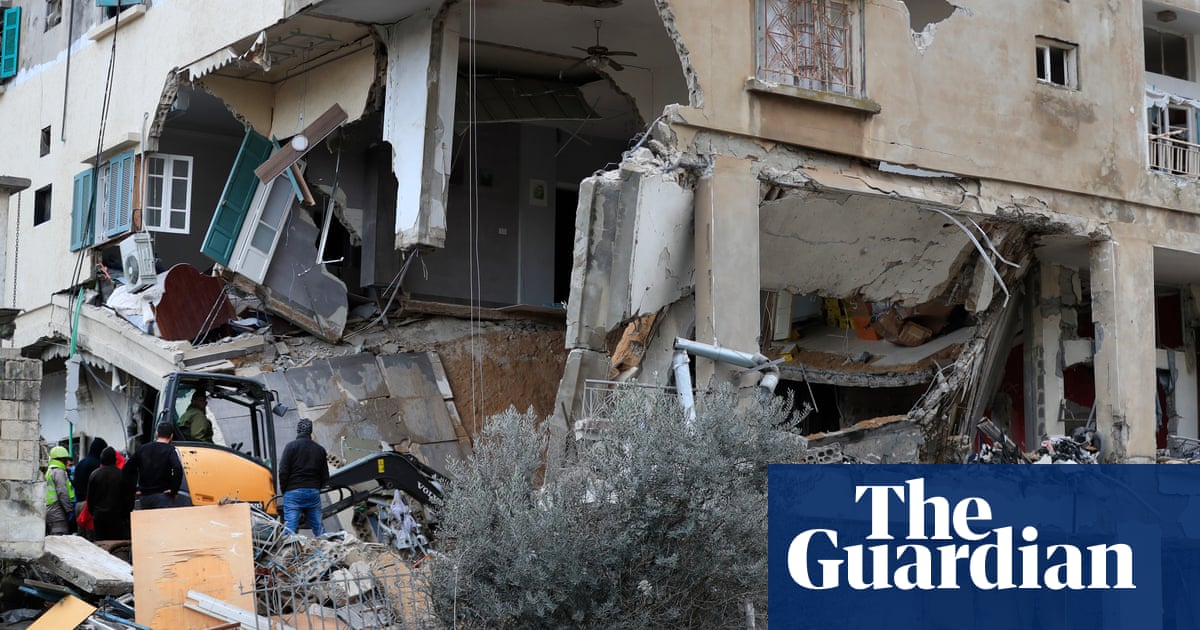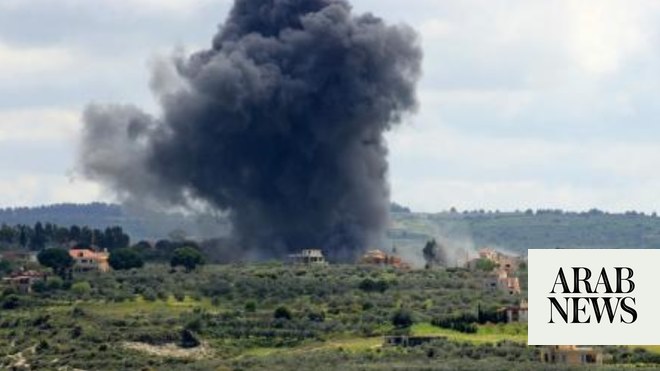
Death toll climbs above 600, with thousands wounded in first 3 days of onslaught
More than 70,000 people have been forced to flee southern Lebanon
BEIRUT: The Israeli military on Thursday stepped up airstrikes on Hezbollah strongholds in Beirut’s southern suburbs and the Bekaa Valley, killing at least one senior militia commander.
For a fourth consecutive day, Israel continued its pursuit of Hezbollah leaders, with an F35 jet targeting a 10-story residential building in the Roueiss area, near the Hezbollah-affiliated Al-Qaim Complex, in south Beirut.
Israel said that the strike killed Mohammed Srur, the head of Hezbollah’s drone unit, who is believed to have overseen recent attacks on northern Israel.
Four people were killed and several others wounded in the strike. Hezbollah has not issued any clarification.
Israel claimed the assassination was in response to rocket fire directed toward Tel Aviv on Wednesday.
In the early hours of Thursday, Israel launched a new round of airstrikes after a lull in exchanges between its military and Hezbollah.
The respite followed international calls for a 21-day ceasefire to allow border issues to be resolved and to reduce longstanding tensions between the two countries.
Prime Minister Najib Mikati’s media office denied reports that he had signed a ceasefire agreement proposal after meeting with US Secretary of State Antony Blinken and US mediator Amos Hochstein.
However, Mikati welcomed the joint initiative led by the US and France, with support from the EU and Western and Arab countries, to establish a temporary truce.
Israeli warplanes launched dozens of deadly airstrikes after Prime Minister Benjamin Netanyahu denied reports of a ceasefire.
In the Bekaa region alone, 155 people were killed and 520 wounded within hours.
For the first time, airstrikes targeted both legal and illegal border crossings between eastern Lebanon and Syria, some under Hezbollah’s control and others used for smuggling.
An attack on a bridge near the Matraba border crossing on the Syrian side injured eight people.
Airstrikes hit the towns of Al-Qasr and Housh Al-Sayyed Ali, including the Al-Arida, Saleh, and Qabash border crossings.
The Israeli army said that it attacked eight border crossings used to bring weapons from Syria to Hezbollah.
Airstrikes killed 15 Lebanese and wounded nine in the town of Karak, near Zahle.
At least 23 Syrian refugees were also killed in the town of Younin in the Baalbek district.
An airstrike destroyed a residential house belonging to Turki Zeaiter in the town of Chaat, killing all members of the family.
A building near the home of Ali Youssef Hijazi, secretary-general of the Arab Socialist Ba’ath Party, was struck, injuring several people. Hijazi was not at home at the time.
In the Bekaa towns, the cries of people buried under rubble could be heard, while paramedics were unable to reach damaged sites for hours due to heavy shelling.
People in the villages appealed via social media to officials and Hezbollah to provide relief to the victims.
Airstrikes destroyed homes in the towns of Nabi Sheet, and Khodor, Brital, Al-Bazzaliyah, and Doures, near Baalbek.
In the south, three people were killed in Aita Al-Shaab and a Syrian national was killed in Qana.
An airstrike killed three young men from the town of Halta while they were in their car.
The Lebanese Ministry of Health said that strikes on Tyre district towns on Thursday killed three people and injured 17.
After halting its attacks on Israel for 16 hours, Hezbollah resumed its strikes, launching dozens of rockets toward Acre and Haifa Bay.
The Israeli army warned settlers to “stay near shelters.”
It said that more than 45 rockets were fired from Lebanon, with some intercepted and others falling in open areas.
An Israeli army spokesman said that about 75 Hezbollah targets in the Bekaa and the south had been targeted, including weapons depots, rocket launchers, and military infrastructure.
Hezbollah said that it targeted the Rafael military manufacturing plant in the Zvulun area, north of Haifa, with salvos of rockets.
More than 70,000 people have been forced to flee southern Lebanon, with thousands more displaced from the Baalbek-Hermel region and towns in central Bekaa.
Many people have also left their homes in Beirut’s southern suburbs.
Newly displaced people spoke of “neighborhoods emptied of their residents.”
Ibrahim, a father of two, told Arab News: “Everyone is scared, and we hope we will not stay displaced for long. No one asked us about our needs and the resources we have. We are trying to rent a house, but we can’t find a single vacant room in Beirut, so we turned to relatives.”
A total of 530 shelters have opened their doors in Beirut and various regions.
MP Bilal Abdullah, chairman of the parliamentary health committee, told Arab News: “The state is stumbling and confused in addressing the needs of the displaced and so is Hezbollah. The government’s emergency plan was excellent, but in terms of execution, it’s safe to say it’s at zero. People would be sleeping on the ground if it weren’t for personal initiatives.”
According to the Lebanese government, more than 600 people were killed and thousands wounded in the first three days of the war.










